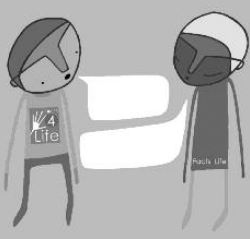Educating children for health
Hugh van’t Hoff, Founder and director, Facts4Life; GP, Stonehouse, Gloucestershire
Published in JHH14.1 – Children’s Health
I qualified in London in the 80s. My medical outlook was profoundly altered by doing the diploma in tropical medicine and hygiene in Liverpool in 1990 where I learned that my outlook was narrow, (over) developed and western.Also that, broadly speaking, wealth is health and that if you want to change the health of a population you need to concentrate on educating that population about their health.To then work in GP in a deprived area of Bristol made me realise we could and should be doing these things here and now in the UK. Putting these ideas into practice has been my work since then. Facts4Life is the result. www.facts4life.or
Facts4Life grew out of my training in both tropical medicine and general practice. Doing the diploma in tropical medicine and hygiene changed my outlook on medicine. It showed me that the medicine we learn in the west is narrow in focus, world health is a political issue, good health is largely a result of higher wealth, improving health can be addressed by increasing the sharing of wealth (narrowing the divide between richest and poorest) and that the education of women and children is a key milestone/aim (these latter ideas are generally called ‘the lessons of Alma-Ata’, the Millennium Development Goals (MDG) and more recently the sustainable development goals – since we failed to meet the MDGs).
Instead of going abroad, I found myself working in a deprived part of inner city Bristol. I realised that the lessons I had learnt in tropical medicine did, after all, have relevance to my GP community. In every nation the burden of ill-health is borne by the poorest. Many of my patients were ill but also poorly educated about health and illness. I also realised that we all hypothesise about why we are ill, who is responsible and what might make us better. Discussions around our differing ideas form the basis of most contacts with general practitioners. On the other hand, I feel we doctors have not done enough to challenge the prevailing ideas we have as a society about health. We are too quick to accept our role as the keepers of special knowledge when in fact much of it could be shared. This and the need to ‘process’ patients has driven the reliance on medication and has fostered an understanding that whatever is wrong with us we probably need a pill or an operation.
Politicians have commoditised health too, promoting the idea that any ill could and should have a cure. This and new media have probably promoted the general feeling that we can achieve perfection in mental and physical health. This ‘perfection agenda’ is, I believe, driving the current health crisis. Perfection is the new normal and anything other than perfection is illness. All illness can and should be cured immediately. We forget that most of the time we get better from most problems – both mental and physical – on our own (the ‘most’ idea). We have failed to get across the key ideas that we heal and that this takes time and needs fostering. These are the fundamental guidelines we use as GPs yet they are so much a part of our ‘medical DNA’ we are unaware of them. We need to share these ideas and more.
Facts4Life is an innovative health resilience programme which is trying to get these ideas across. It is designed for primary age children. It helps young people take ownership of their health by exploring illness and increasing motivation to develop strategies for wellbeing. The programme is about to be extended to secondary schools in the county. We have developed a training programme for teachers, introducing them to our ideas and resources which embed matters of health within the curriculum. Funding has been provided by Gloucestershire Clinical Commissioning Group.
The context
Facts4Life has been developed against a background of growing crisis within the medical world. Political and social pressures have created a context in which there are ever[1]increasing expectations made on practitioners. In so many cases, the burden of responsibility now weighs upon those in primary and secondary care to ‘fix’ patients, to make good the shortfall in the individual’s perception of how they should be feeling, often through medical or surgical intervention. We aim to challenge this context in three significant areas.
Responsibility and shared decision-making
It is no surprise that patient expectations increase in the light of improved recovery rates from serious illness, the ability to function well despite chronic disease and the greater accessibility of information through the use of Google doctor and other online oracles. The question is: How do we best give people the ability to make sensible decisions about their health? At the moment, this tends to be addressed downstream by complicated ways of shared decision-making (SDM). SDM between patients and health professionals in primary care or secondary care settings is supposed to ensure that the patient is in the correct mental space to make a decision. The effect can sometimes be to bamboozle the patient with information. It jars with some patients who have come specifically to see their doctor for guidance. The idea of meaningful SDM seems ridiculous, if patients have no insight into the way doctors think.
The perfection agenda
It is a paradox that in spite of the evidence that we are becoming healthier by most measures, there remains a growing perception of the threat of illness. This I call the wellness or perfection agenda. It is the idea, promoted by advertising and a lot of traditional and new media, that we should have a perfect body and/or perfect health. It is also the consumerist idea that if we don’t have these things then we should be able to do something about it. If we don’t have a perfectly functioning body, we are likely to feel this constitutes an illness and that health professionals should make us better, often immediately. The medical profession has unwittingly connived with this demand or certainly failed to challenge this perception.
The under use of lifestyle interventions and the need for instant solutions
The drivers that promote the use of drugs or surgery as an intervention, when lifestyle changes would be more effective, are many and various. They are justified at times intellectually and financially, supported on grounds of greater professional efficiency and reinforced in training. However, in the 30 years I have been practicing medicine I have seen a wholesale change in the attitude towards health and lifestyle. For example, people with osteoarthritis used to be told to rest as much as possible and now are encouraged to lose weight and exercise. There are virtually no conditions where exercise is now thought to be harmful. Despite this change in attitude, the pressures on time, both within the consultation and more widely within our culture, mean that drugs or surgery are the preferred solution to the problem on both sides. In this context it is often extremely difficult to hand back the responsibility to the patient and encourage lifestyle change. This is clearly a very complex issue. But it is also clear that the NHS as an organisation has made an implicit contract with the population to take responsibility for the problem and provide the instant cure, even if this is not in the patient’s long-term interest.
at times intellectually and financially, supported on grounds of greater professional efficiency and reinforced in training. However, in the 30 years I have been practicing medicine I have seen a wholesale change in the attitude towards health and lifestyle. For example, people with osteoarthritis used to be told to rest as much as possible and now are encouraged to lose weight and exercise. There are virtually no conditions where exercise is now thought to be harmful. Despite this change in attitude, the pressures on time, both within the consultation and more widely within our culture, mean that drugs or surgery are the preferred solution to the problem on both sides. In this context it is often extremely difficult to hand back the responsibility to the patient and encourage lifestyle change. This is clearly a very complex issue. But it is also clear that the NHS as an organisation has made an implicit contract with the population to take responsibility for the problem and provide the instant cure, even if this is not in the patient’s long-term interest.
The Facts4Life response
We begin by responding to the interest of young people in their own bodies, their health and their experience of illness, through the use of educational materials in the classroom. We are also extending this dialogue to the families and wider community, including medical practitioners in primary care.
Our three key messages are:
- Riding the ups and downs – life is a series of ups and downs. As a society we have to accept this and help our children understand it too. This is a message about the journey we take in a state of flux between health and ill-health.
- Keeping in balance – our bodies naturally keep themselves in balance both physiologically and in terms of our mental health. This is the key medical fact we’re trying to get across – most of the time we are in balance and most of the time we get better on our own. Exploring illness helps us understand these forces in action.
- Smoothing the path – with the previous two messages in mind, it follows we can reduce the ups and downs by paying attention to the factors which keep us in balance.
 We seek to influence the perceptions that children have about illness from an early age. We also need to give them opportunity at an appropriate level to learn about some of the important facts and approaches that are addressed at medical school so that they can understand the way that we health professionals think about illness, attitudes to risk and the determinants of health. Many quite complex subjects can be explained with the help of analogies or metaphors – I’m sure many of you practise this. We can reassure children that illness is, by and large, another challenge that they can meet in the same way that they meet educational challenges that are presented to them.
We seek to influence the perceptions that children have about illness from an early age. We also need to give them opportunity at an appropriate level to learn about some of the important facts and approaches that are addressed at medical school so that they can understand the way that we health professionals think about illness, attitudes to risk and the determinants of health. Many quite complex subjects can be explained with the help of analogies or metaphors – I’m sure many of you practise this. We can reassure children that illness is, by and large, another challenge that they can meet in the same way that they meet educational challenges that are presented to them.
We are building partnerships with GPs and sharing our approach and the language of our materials with practices that are working within the communities of Facts4Life schools. One of the central aims of Facts4Life is to improve the dialogue between health professionals and patients so that people feel they have better ownership of their own health. Ultimately, we see Facts4Life as altering the nature of this dialogue so that in time patients will feel that they have a collaborative, rather than hierarchical, relationship with the healthcare professional.
By providing opportunities in the classroom for young people to explore the wide range of normality in their health experience and in the experience of others, we can begin to address the ‘perfection agenda’ and the unattain[1]able expectations it brings. The central idea within the resources of ‘riding the ups and downs’ brings a dose of realism to the notion that wellness is a constant that can be provided by others.
By providing opportunities in the classroom for young people to explore the wide range of normality in their health experience and in the experience of others, we can begin to address the ‘perfection agenda’ and the unattain[1]able expectations it brings. The central idea within the resources of ‘riding the ups and downs’ brings a dose of realism to the notion that wellness is a constant that can be provided by others.
When I heard Hugh van’t Hoff’s presentation about the initial evaluation of the programme and the outcomes, I was completely blown away.The only positive, constructive idea on solving the NHS’s problems in a positive and preventative way that I have heard in my entire 40-year career in medicine.
Stroud GP
I think the most interesting part for me was when we learnt how to fight some of the diseases and the common cold and a lot of those things because it could help me in the rest of my life so I don’t get the worst part of it.
KS2 (8 to 11-year-olds) student
I feel having Facts4Life’s comprehensive health education programme is such an important part of the curriculum… to help prevent illness and promote healthy living.
Parent
The delivery of the training was really slick and focused. I was fascinated by the ‘sciencey’ bit at the start of the presentation as it put the Facts4Life work in context.The presence of a GP and paediatrician gave the programme credibility. It was a great starting point for us to re-think our PSHCE programme with current up-to-date thinking and issues that relate to the children of today.
Cheltenham Headteacher







